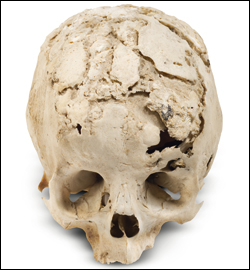UAB collaborates in an exhibition on diseased skeletons

10/02/2009
The pieces forming part of the exhibition were carefully selected by the doctors and date from different eras, from Prehistory to Modern Times, and demonstrate a wide range of pathologies: congenital or degenerative anomalies, infections, tumours, traumatisms or injuries inflicted with violence. The skeletal remains also reflect alterations produced for cultural reasons, such as cranial deformations, trepanations or mummification. Their analysis from an evolutionary viewpoint demonstrates that the large groups of diseases suffered by our ancestors do not differ much from the diseases suffered by humans today.
Palaeopathology studies the vestiges ancient diseases have left in human and animal remains. Thanks to their research the health of an entire population can be examined, while additional analyses can lead to discovering the lifestyle of a society during a specific period of time. Skeletal lesions are where palaeopathologies are best identified and diseases have even been documented in ancient skeletal remains. The exhibition also shows traces of diseases existing before the birth of modern man, with skeletal wounds from two dinosaurs from the Cretaceous Period, a Pleistocene elephant and different trilobites.
Part of the exhibition is dedicated to molecular analyses since several genetic or infectious diseases can be discovered using these types of analyses. Infectious diseases moreover can in some cases affect bones, and this has frequently been the case in many archaeological findings.
One of the emblematic pieces of the Museum's permanent exhibition, the "Dame of Kemet", served to show the process of a multidisciplinary scientific study in which samples were obtained from both skeletal and soft tissues and analysed with more modern methods.
Distributed over a 300 square metre area, the exhibition will be on display until 30 June.